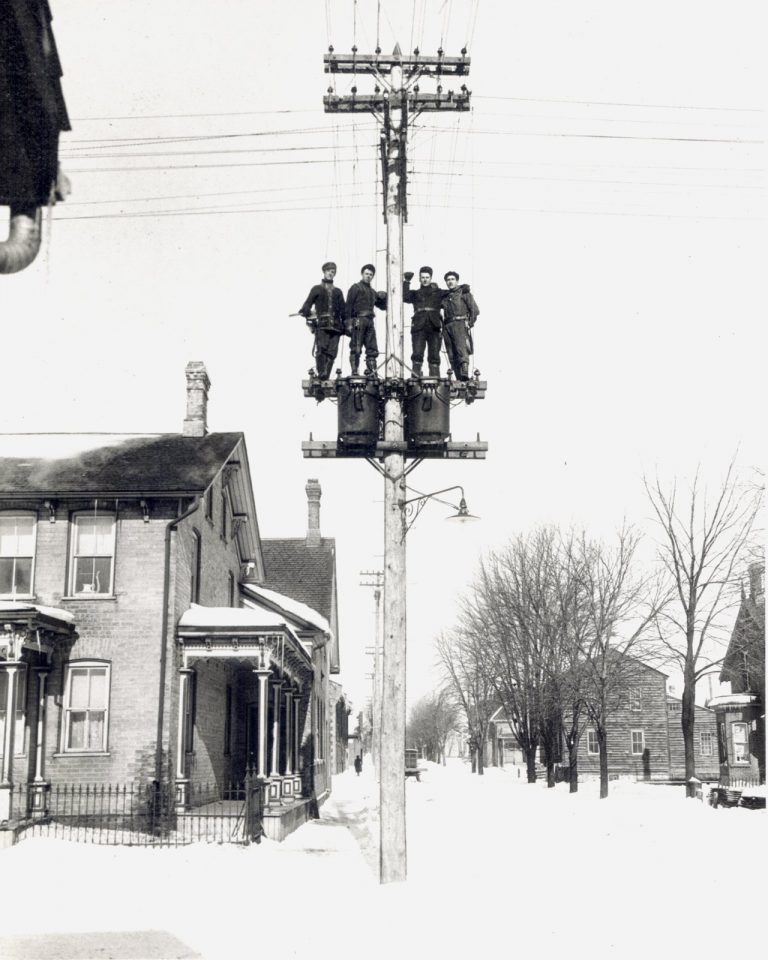On Dec. 3, Waterloo Public Library posted a photo on social media which sparked the interest of many. The photo featured four men: Bert Warner, James Walker, William Reiber, and Eby Rush, standing on a distribution transformer in 1912.
“The Squirrel Gang,” as they were affectionately known, were a team of linemen for The Water and Light Commission (now Waterloo North Hydro) and responsible for the construction and maintenance of electrical power lines.
These four men, along with all linemen of the time, worked before the safety measures of the 1950s, like rubber gloves, hard hats and safety goggles, were implemented. At the time, safety measures differed in each city, and province-wide safety standards did not become fully established until the late 1960s and early 1970s.
Due to the high visibility of this job, the “Squirrel Gang”, captured the imagination of many young people, and their work was often idolized.
“I always admired my father when he was up the pole, I thought someday, I want to be doing that … when I got old enough, about thirteen, I guess, I helped myself to the spurs,” Bob Detweiler said in an interview conducted by John Jason Wilson in his book Squirrel Gangs, Street Lights & Bucket Trucks: The History of Waterloo’s North Hydro.
Detweiler went on to explain, “we lived very close to a railroad track and they had all their telegraph poles along the ditch, there were a couple of poles down there that had a lot of marks in them because I practiced on them … by the day they hired me, I could already climb.”
Eby Rush, one of the linemen in the “Squirrel Gang” had a long history working with Waterloo’s street lights. Rush was responsible for servicing the original three carbon-arch street lights on King St., provided by William Snider’s electric works.
These lamps hung on ropes from wooden poles, and in order to be cleaned or fixed Rush, and others would have been required to pull them down each time. These original lights had their problems — the lamps spluttered and blinked, and the carbon rod burned away over time. They were also expensive, and in order to save costs, they were required to be turned off on moonlight nights.
Rush worked with the Water and Light Commission for over fifty years. In 1938 he became the commission’s superintendent and held the position until his retirement in 1955.
In 1908, Ontario Hydro and Waterloo signed the first contract for the supply of 511 kilowatts, and between 1911-1912 Rush helped install much of Waterloo’s tungsten lights on King St. between William St. and Laurel St., removing the three carbon-arch street lights.
On Nov. 11, 1911, Waterloo held the King St. light inauguration, where the new system of tungsten street lighting was officially turned on.
The Waterloo Chronicle reported that when the new tungsten system of street lights was inaugurated, O’Canada, played by the Waterloo Music Society, could barely be heard due to the prolonged cheering across King Street. This marked a new era of history in the making for Waterloo and will live in the memory of those who witnessed it.
Rumour has it that this event prompted Sir Adam Beck, who founded the Hydro-Electric Power Commission of Ontario, to proclaim “Waterloo was the best-lighted [lit] town in Canada.”

